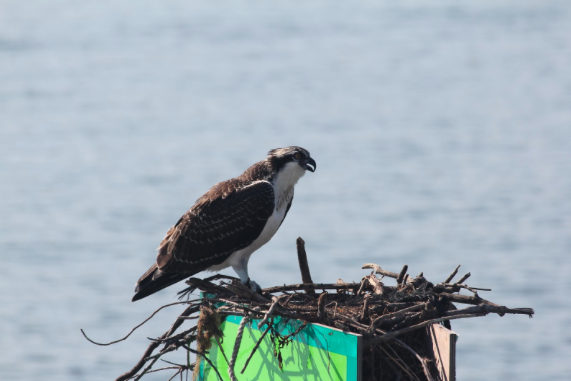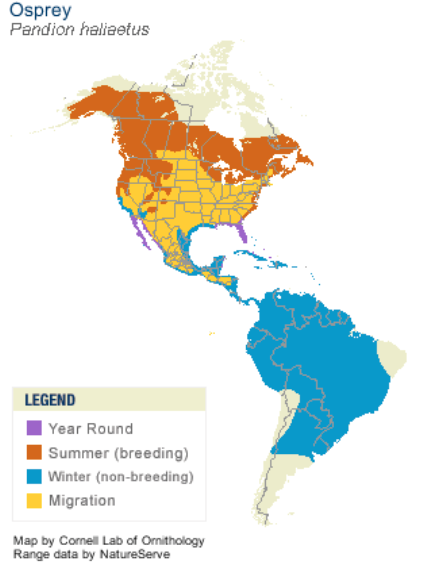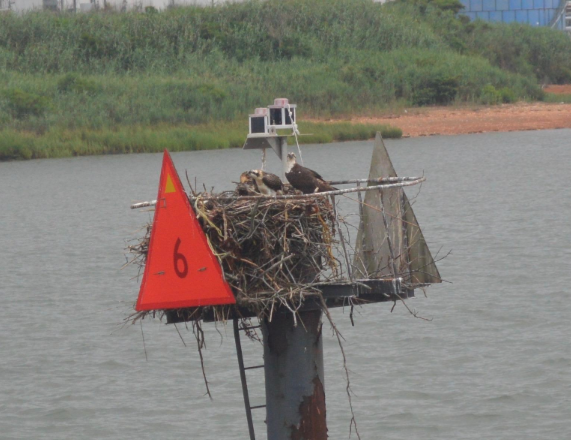How Garbage Is Harming Adult Ospreys and Their Chicks
How Garbage is Harming Adult Ospreys and Their Chicks
Ospreys are one of New Jersey’s largest species of raptors. They have a wingspan of about 59.1 inches to about 70.9 inches, and can weigh from 49.4 ounces to 70.5 ounces (Osprey Life History, n.d.). They are usually easy to spot when flying due to their white underside. They also have a mostly white head with a brown stripe that crosses their eyes, and their backs are mainly all brown. These raptors are very different as compared to many other birds of prey, because they feed almost exclusively on small fish, as compared to other raptors that tend to eat a wider variety of species, such as small mammals and other birds. Due to their diets, of primarily fish, they need to live near water.

Image 1 Adult osprey. Photograph taken from the Cape May Whale Watch and Research Center Database.
Ospreys, also known as fish hawks, are a commonly seen bird along rivers, lakes, and coastal areas in many temperate and tropical regions around the world. The population of ospreys that inhabit New Jersey in the summer time months usually nest along the coastlines running from Sandy Hook to Cape May. By looking at satellite transmitters, which were fitted onto a number of individuals, researchers have been able to see that the majority of New Jersey’s population travels to Northern South America in the winter (Liguori, 2003).

Image 2 Osprey distribution in North and South America (Osprey Life History, n.d.).
Due to the ospreys’ need to live close to large bodies of water, this means they are largely affected by humans, especially since about 40% of the world’s population lives as close as 63 miles from coastlines, not to mention people traveling to the coast for pleasure, work, etc. Due to ospreys living in areas where there tends to be larger populations of humans they are widely impacted by human actions. One of the most well known human threats that almost caused the osprey to become extinct was due to the spraying of DDT. DDT was a chemical that was heavily used during the early 1970s in order to control the mosquito populations.
What people did not know at this time was how bad this spray was for the environment, and all of the organisms within it. This chemical was mainly sprayed in areas near bodies of water, because those were the types of environments that the mosquitos would commonly breed. Due to this the DDT would fall into the water, which would then accumulate in plankton, that would then continue to climb its way up the food chain into the fish, and then finally into the ospreys that were feeding on the fish. This caused biomagnification within the ospreys. The build up of this chemical within these birds, as well as many bald eagles, caused the ospreys eggs to become very brittle, and the birds would unfortunately break the eggs when they tried to incubate them (Fears, 2016). Once the research came out that this chemical was causing harm DDT was banned around the mid 1970s. The ban thankfully allowed the osprey population to flourish once again from having only about 50 nests in 1974 to well over 600 nests today in New Jersey alone (Liguori, 2003).
Although DDT is no longer in use, there are still many human threats that cause harm to these birds. Humans continuously pollute the land and water with toxic chemicals, trash, and plastic. Due to people not disposing their trash, plastics, and other objects the way they are supposed to, has lead to many dangers such as different animals choking, getting sick, becoming entangled, etc. Over the years there has been a growing amount of ospreys using this trash to build their large nests, which can be a huge safety concern when it comes to their chicks, as well as the adult nesting ospreys.
Ospreys are mainly monogamous, and mate for life. The breeding pair typically uses the same area, and sometimes even the same nest each year to lay their eggs. They typically make these large nests on top of buoys, artificial nesting platforms, dead trees, and other areas high above ground, and close to the water. The male usually arrives at the nest a few days prior to the female’s return in order to gather supplies for the nest. The nest is often five feet across and two to three feet deep when first built, and they increase in size each year after the male adds to it (Osprey, n.d.). The materials used to make these huge nests usually consist of bark, sticks, and any other material they feel will work well in the nest. Unfortunately this means they may feel that garbage, such as varieties of plastics, balloons, twine, fishing gear, and many other man made materials that they should not be using, and could possibly cause harm to the adults or their chicks.
Since these birds live both very close to humans, and the sea, it makes it very easy for these birds to find plastics and other types of garbage to help build their nests. People tend to be careless with their trash and commonly do not dispose of objects the way they should. People commonly litter without any idea of how harmful it could be for the environment and the organisms that live there. Some of the most common pieces of plastic found in osprey nests are plastic ribbon from balloons and monofilament fishing line (Cirino, 2017). These types of trash are extremely dangerous because both the chicks and adults commonly become entangled in the string. The entanglement can cause them to break a wing or leg due to the struggle of them trying to escape, can cause an infection if the object causes them to gain an open wound, they can be strangled, they can starve to death if they cannot become freed, and many other terrifying scenarios.

Image 3 Osprey nest with twine, taken by Alexandra Blanchet – 2017.
Plastics are made to last. They do not degrade like wood, paper, or other pieces of garbage over time. This makes this type of trash even more dangerous because if it is in the osprey nest it will be there until the nest falls apart, and when it does another osprey may find it to use, or another animal may eat it or become entangled in it.
Fortunately, because ospreys live in areas where there is a large population of people, and since they are also a protected species within the United States, people tend to care about this specie. Especially after the outbreak of DDT, and many people within shore communities that help in building nesting platforms for these birds’ people seem to take interest in them. Due to them being close to where people live, vacation, or fish, if someone sees an osprey that looks like they are having trouble, usually trouble with being entangled, they will contact someone in order to help. This makes it easy to see if they need help, as compared to other species or birds or other animals that do not live as close to humans, and are as easy to see and have access to. Even when people are able to help an osprey that is entangled that does not always mean that damage hasn’t already been done. The bird could have still broken a wing, or a leg, or have gotten a wound from being trapped. Sometimes the bird it able to get further help, but often times this means it will need to go to a rehabilitation center. If the damage is very sever the osprey may not be able to be released, like in the case of a broken wing, or it could unfortunately die within the time of it being cared for due to infection if it had a wound.
Ospreys can also choke on garbage if they try to ingest it. Even if the bird is able to eat it, it can cause a number of problems after they have ingested it. Some of these problems include the bird not being able to digest the garbage properly, or it can make them very sick. Ospreys, along with most other animals, are not able to digest plastic. This means that if they continue to eat plastic it simply stays within their stomach and it will not be broken down the way food should. If they ingest enough plastic to fill their stomach it can cause the bird to feel full, and will eventually die due to starvation.
Unfortunately, unlike seeing an osprey that is entangled, we cannot see with our naked eye, and without medical equipment, if an osprey has ingested too much plastic. Regrettably in this case, we do not usually see that the osprey has a problem until it is too late.
To help ospreys, as well as other local sea creatures, we need to come together and come up with more ways of disposing trash properly. It is said in the United States alone about 33.6 million tons of plastic is discarded every year. Of that amount only about 6.5 percent of that plastic is recycled, and about 7.7 percent is combusted in waste-to-energy facilities (Cho, 2012). This leaves about 85.8 percent of our plastic not being recycled properly. These numbers also do not represent the amount of the countless millions of pieces of plastic that are not thrown away, and instead are left to sit in the environment it is at until someone comes across it and chooses to dispose of it, or it will simply stay in that spot forever, or even if it is somewhat broken down it will add to the countless amount of micro-plastics that are in our environment, which also adds harm to the food chain.
There are various steps that can be taken to help lessen the amount of plastics and other types of garbage that find their way into osprey nests. One step is to have more trash cans and recycling bins that are regularly emptied at all times of the year on beaches, boardwalks, and other areas close to the water that people commonly go to. There should also be bins on beaches and popular fishing areas where fisherman can safely discard various fishing equipment that they can no longer use, such as torn fishing line. Shore communities should also make an effort to have more beach cleanups at all times of the year, and invite different environmental organizations to help in the cleaning, that way there are more people to help clean the area of objects that can harm the environment and the species within it.
It is also important to consider getting rid of the wasteful habit of using single use plastics, such as plastic bags, plastic water bottles, straws, and plastic utensils. Instead, when you go grocery shopping you can use reusable shopping bags. These types of bags will not only lessen the amount of plastic bags being thrown out into the environment, but they also typically hold more items, and they are more durable and less likely to break than plastic bags. Instead of using plastic water bottles you can invest in a reusable water bottle. There are countless types available, and it is much cheaper to buy one water bottle to reuse than buying a case of water close to every week.
These are only a small amount of solutions that we can take to reduce the amount of trash and plastics within the environment. By taking care of this problem we will be helping this amazing species of bird, as well as so many organisms that are heavily influenced by humans not being able to dispose of trash appropriately. After coming close to losing almost all of the ospreys at one point in time, we do not want to make another mistake in harming them again, and possibly causing them to go into another decline. The only way that we can stop this problem is by taking care of our environment and making smarter choices when it comes to its health, and every other species that lives our coastal environments.
